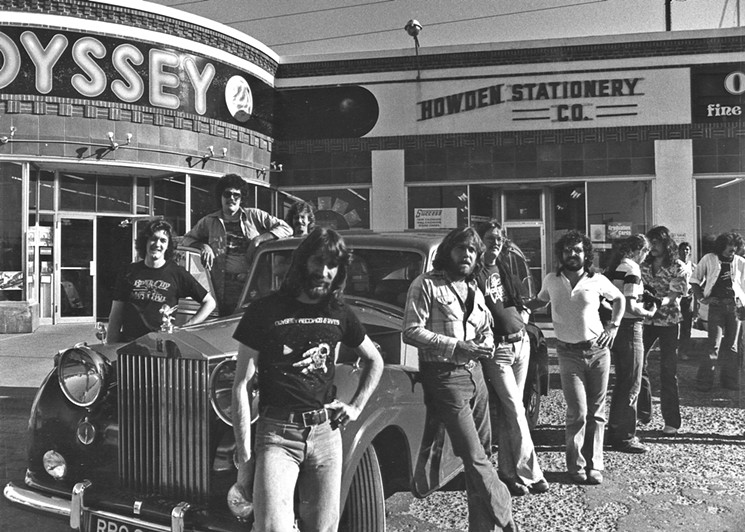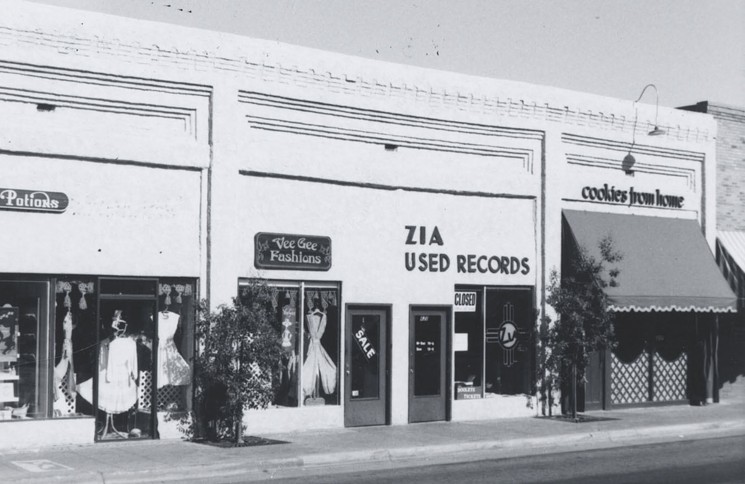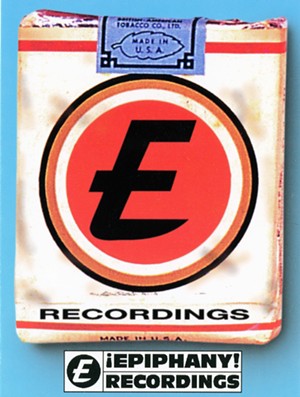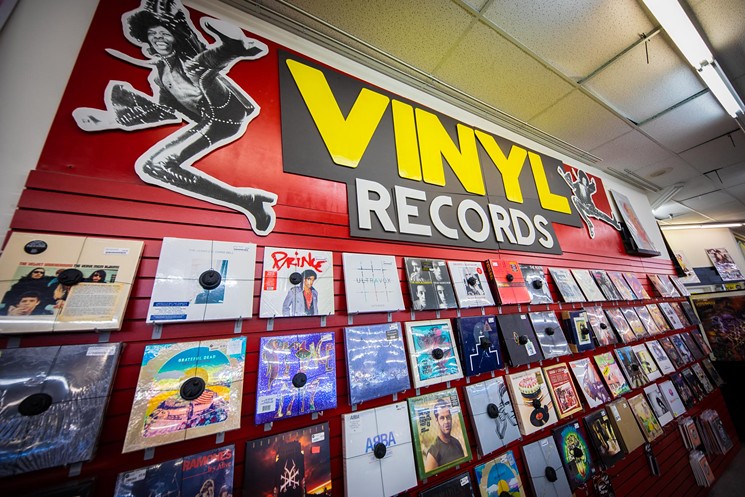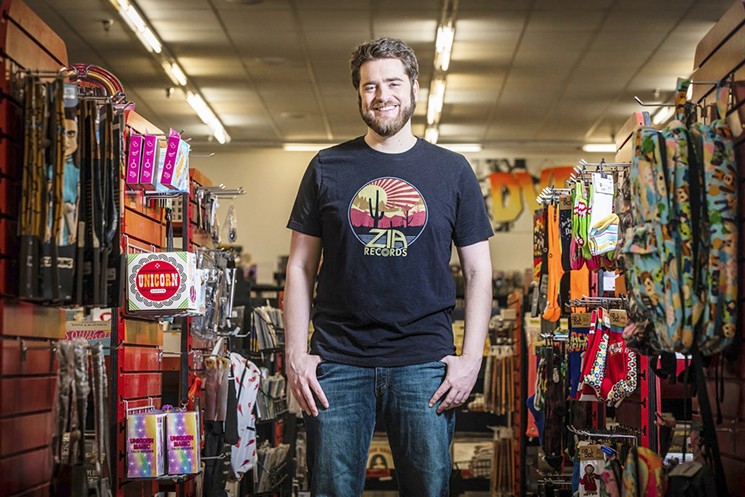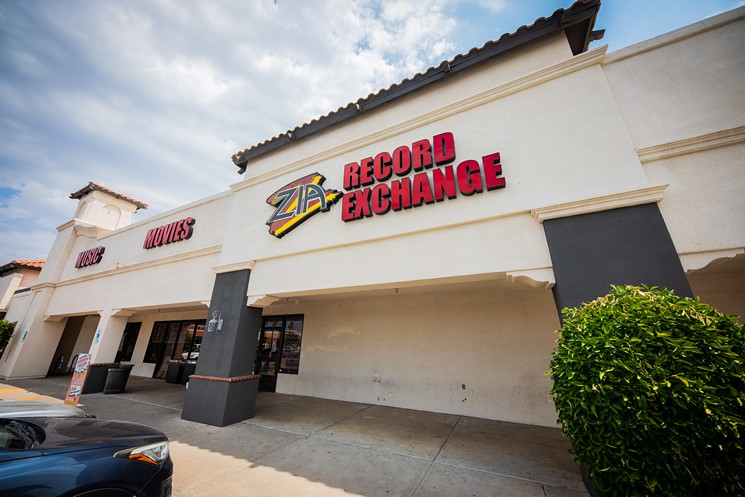Framed gold records — recognition for selling unholy amounts of Incubus and Linkin Park CDs — hang above the doors to the offices. A giant black Against Me! poster, used for previous in-store appearances at local Zia stores and autographed by the members of the band, adorns one wall; on the other side of the room, an old refrigerator door covered in 2000s-era Zia stickers leans against another.
Dig around and you’ll find recent collectibles (Baby Yoda Chia Pets!) located near guitar-shaped pizza cutters. A stack of locals-only compilations, released by Zia. Architectural plans for Zia’s first Chandler store. A whole bunch of Best of Phoenix awards from the publication you’re currently reading.
“We need to get everything into an actual archive someday,” says Jason Woodbury, Zia’s marketing director, “but we haven’t gotten around to it, ’cause we’re constantly busy.”
Perhaps the rarest piece in the collection is a bright-red paddleball game, a holiday gift given out to Zia employees that dates back to the 1990s. One side features the phrase “Zia takes the hits”; the other has a goofy, gonzo-like photo of the face of Zia’s founder, Brad Singer.
Singer launched the chain in 1980 from a single store at 19th Avenue and Indian School Road in Phoenix. It was a tiny, idiosyncratic shop with an indie/underground bent, an oddball staff, and an emphasis on quality used music. A die-hard music lover, Singer opened Zia with records from his collection, a loan from his mother, and homemade bins built from 2-by-4s.
He catered to music fans and collectors, worked 12-hour days, and built a following through old-fashioned word-of-mouth. The people came, and they kept coming: vinyl junkies looking for a new place to get a fix, punks crawling out from the underground. Zia became a wayward home for weirdos, both in front of the counter and behind it.
From these humble beginnings, Singer spawned a retail and cultural empire that would expand to Tempe, Tucson, and eventually beyond Arizona. By the early ’90s, Singer owned multiple stores in the state, his own distributor, and an indie label. By the time he died in 1998, he had revolutionized the business of buying, selling, and trading music in Arizona.
But we’re getting ahead of ourselves. Below, we’ve assembled a playlist of memories from the many folks — employees, longtime patrons, local musicians — who were along for Zia’s wild ride over the last four decades (and counting). Enjoy.
When Singer was growing up in Phoenix in the 1960s, he dreamed of becoming a rock god or stand-up comedian.
Sandra Singer, Brad Singer’s ex-wife: Brad didn’t have a work ethic until he found his niche. Probably around 16 — I think that’s when he got a serious interest in music and wanted to do something in that. He tried branching out by working at [now-defunct retailer] Bill’s Audio and setting up stages. Brad worked for Evolution Records. After that, he went to Odyssey Records.
Jim Tessier, Singer’s former co-worker at Odyssey Records: Brad managed the 8-track and cassette tapes at Odyssey on Camelback. He really took his job seriously. In a world of lazy hippies at the time, Brad was the complete opposite.
Sandra: We hit the road when he worked for Odyssey Records. We went to Ogden, Utah, and he was assistant manager [at that store]. Then we went to Albuquerque and lived there for about a year and a half and managed the Odyssey Records there. That’s where we got the name Zia, because we loved living in Albuquerque. Everything there is named Zia. We came back, he got a loan from his mom, and opened the first store.
John Dixon, Arizona music historian: Brad put up his own records to start the first store until stuff started coming in. He had a huge collection and diverse tastes.
Sandra: It wasn’t necessarily mainline music. We never listened to Fleetwood Mac, because [Brad said], “We can’t listen to that.” He was really into Zappa and liked Gram Parsons, too. When we were in Albuquerque, disco was a thing. So we got into country — real country, like Willie and Waylon.
Dixon: The first store was tiny, but you’ve got to start somewhere.
Sandra: Call it 1,300 [square feet] and you’re about right. It looked really homemade. When it opened, it was called Zia Used Records and Incidentals. We brought in jewelry, stickers, and goofy stuff like that — handcuff earrings and all kinds of jewelry with skulls.
Dixon: There were other used places like Bird’s [Record Exchange] in Tempe. Circles [Records] was going, but they didn’t deal in used, and Odyssey Records dealt primarily in new, but you could trade there.
Michael Pawlicki, owner, Ghost of Eastside Records: Used stores were rarer than they are now, but there were little weird ones scattered about, like Record Trader in Tempe.
Sandra: We did resale because it’s recession-proof. If it’s good times, you’re selling a lot because it’s cheap. If there’s bad times, you’re always buying good product because people need money.
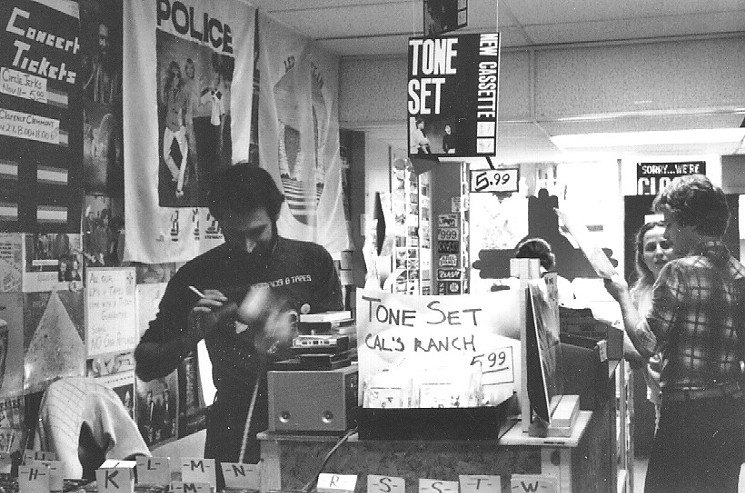
Brad Singer works behind the counter at Zia's first Phoenix store in the early '80s.
New Times archives
Sandra: We were in the black from day one. I know Brad advertised in the New Times and we maybe did fliers right away. He was always at the store, like 10 to 12 hours a day for a while, so it was pretty much word-of-mouth.
Jesse Srogoncik, Zia’s first employee: Brad started it on his own and was open for six or seven weeks and was utterly exhausted. I was working at a record distribution warehouse for a guy named Cubby. Brad knew him and hired me away.
Zia may not have been on the general public’s radar (it wasn’t included in an Arizona Republic roundup of local record stores that summer) but collectors, music fans, and the underground slowly began to discover it.
Srogoncik: [The clientele] was fairly diverse — what you’d expect from the record-collecting crowd, the same one shopping at Evolution, World Records on 16th Street, or [Rolling Stones Records]. All those people knew each other, just because they loved music.
Pawlicki: It was the first used record store I discovered. I’d gotten into underground music in high school — whether it was reggae, free jazz, country blues — and started hunting those records. One of the first places I found stuff like that was Zia. I lived in south Scottsdale and rode my bike 15 miles to get a Burning Spear or Albert Ayler record. No one had everything like Zia. Roads to Moscow carried punk things. [Tower Records] had a little import section. Zia had it all.
Srogoncik: Brad was always keen on diversifying his selection and having alternatives [to more mainstream music], so he experimented smartly with one bin at first, primarily imports. It’d be, like, The Damned, the first Clash album, and 7-inches like “God Save the Queen” or “In the Beginning There Was Rhythm” by The Slits. It sold out pretty quickly. And that’s leaning more toward the outrageous shit at the time, because Tower had imports too.
Dixon: An important part of his marketing was the quality of records. [At other shops], it was sometimes “buyer beware,” and if you got home and a record started skipping, you were outta luck. That was never a thing at Zia.
Srogoncik: We worked our asses off to keep the stock clean, varied, interesting, easy to find, [and] not effed up.
Pawlicki: The people engaged you. I discovered there was a local music scene and bought the first Meat Puppets 7-inch, which I obsessed on immediately. I was a pretty high-strung kid — nice, but a bit loony. Brad just walked up and asked if I wanted a job.
Toni Koch, early Zia employee: Zia was where misfits could go and feel like we were doing something of value.
Zia expanded after its early success in Phoenix. In 1982, a second location opened on Mill Avenue near Fifth Street in Tempe. Two years later, a store at 19th Avenue and Thunderbird Road followed.
Srogoncik: Each location was unique and stocked differently, so the used records of each community really reflected that community.
Koch: The original store was urban but still rock 'n' roll. Tempe was more college.
Dixon: It was a battle of aromas at the Tempe store. Lotions & Potions was on one side, Cookies From Home on the other, and Zia in between. And then you’d get the wafting of the shrink-wrap machine from the back.
Marilyn Whitelaw-Rothmund, former Zia employee: I first heard about Zia in the early ’80s when I was a young, New Wave, punk kid out with my girlfriends. One day, Brad hired me because I was there all the time. He put me in the back room. I was the shrink-wrap queen and almost got high off the fumes.
Dixon: It was a big deal to reseal [records]. A lot of used stores didn’t. It was a nice presentation and a little more effort.
Kimber Lanning, owner, Stinkweeds Records: My older brother took me to the Phoenix location. I even remember what I bought: that Gang of Four self-titled EP and XTC’s English Settlement. I was hired in 1983 when I was only 15, but Brad didn’t know that. I couldn’t drive, so my dad dropped me off nearby.
Whitelaw-Rothmund: The best thing about working there was getting turned on to new music. One afternoon, Brad said, “You need to learn more about the basics.” So he and Sandra made lunch and he played me a bunch of music. He lent me piles of vinyl to listen to at home.
Lanning: Brad always wanted to be a community hub for music lovers. Just where people could hang out and find stuff they didn’t know about.
Cait Brennan, singer-songwriter: I’d go to Zia on Thunderbird Road after it opened. The people working were strange. The stuff for sale was definitely stranger. I’d been a rube from the sticks and hadn’t heard a lot of German industrial before
Sandra: I don’t think Brad’s plan was to have a little mega-empire. I think after things started rolling and we had the Tempe and Thunderbird Road stores, then it [became] like, “It’s going to grow.”
In 1986, the original Zia store relocated to larger digs at Seventh and Montecito avenues. The following year, Singer launched the one-stop distribution company Impact (later known as Impact Music) in order to get better deals from record labels. Also in 1987, the Tempe store moved to a bigger location on University Drive near Mill Avenue. Meanwhile, Pawlicki, Lanning, and other Zia employees departed to launch their own stores.
Pawlicki: The first store got robbed a few times. No wonder Brad wanted out of that area.
Dixon: One of the reasons the Indian School store went to [Seventh Avenue] was Brad [was planning to open] a one-stop, which meant he could get better prices from the major labels for Zia and also sell to other smaller, independent stores. He needed more room for more stock.
Kip Dean, former Impact employee: It made sense. As a distributor, we could get music cheaper than if we were just a couple retailers. I’d worked at the Thunderbird location for a month and Brad said, “You’re the worst clerk I have, but you do a lot. Want to move to Impact?”
Brennan: Brad was a larger-than-life character. Somewhat mercurial but brilliant and painfully honest at times.
Pawlicki: He was a very driven business person. Worked hard. Extremely hard. All those Zias didn’t succeed by accident. I think that influenced Kimber.
Lanning: Brad and I had a good relationship, but he wouldn’t move me into any management position. He kind of laughed it off, saying no one would ever listen to a 100-pound woman. I chuckled to myself and went, “I’ll just open my own store.” I gave my notice and started Stinkweeds that May.
Pawlicki: [Brad] was talking to me about being general manager, and I didn’t know if that was me. Things were getting bigger, and he had bigger ambitions than me in terms of business. I was more of an underground person who didn’t want to manage a chain. When Clayton [Agent] and Ben [Wood] left and opened Eastside Records that summer, they called and offered double what I was making.
In 1988, Singer launched an in-house design studio for Zia, Impact, and Singer’s other projects called CHUD Graphics.
Dixon: This husband-and-wife team [Mike and Jodi Maas] designed all the fliers, ads, endcaps, and displays for Zia. Brad realized he’d save money by doing it in-house. They made everything look amazing.
Jodi Maas, former CHUD Graphics artist: I started in 1989-1990 and Mike followed a few years later. It was my absolute dream job. Brad would let us do almost anything we wanted; maybe a handful of things he turned down because they were too crazy. We had a lot of artistic freedom with the Zia Zine [a promotional publication given out at stores], T-shirts, ads, and everything else. It was mostly done in Mike's [artistic] style, his graphic, bold style with a lot of real edgy ideas.
Mike Maas, former CHUD Graphics artist: We were just being punk rock [with our art], basically.
G. Brian Scott, bassist, Dead Hot Workshop: Me and [Gin Blossoms vocalist] Robin Wilson worked for Brad in 1988 at the Tempe Zia. We were clerks, but Brad decided to fire one of us to split us up. I went back to working at Tower Records, Robin went on to do Gin Blossoms, and I followed him with Dead Hot [Workshop]. I still loved Brad. We’d seen him at shows or drinking at [Long Wong’s] for a few years. He’d become big in the scene.
Stephen Ashbrook, singer-songwriter: I think every musician in Tempe worked for Brad at some point.
Singer released Zia’s first locals-only compilation, 357 Miles East of L.A., in 1989. The 12-song cassette mixed scene veterans like Hans Olson and Walt Richardson with newer bands like Dashboard Mary. Other cassettes followed, including 1990’s Lizards, which featured acts like Quake, Empire of Desire, and Dead Hot Workshop. Many more local comps would be released by Zia in the years ahead.
Dixon: Those cassettes were purely a loss-leader thing and just loaded with local music.
Scott: I still have the tape at my house. If you were unknown or not familiar with Brad, to be on a compilation with other bands relatively bigger than you are, and it’s at every Zia? That’s huge.
Brennan: He did everything he could to support locals. He was out at shows, had bands doing in-stores, putting out comps. If a band hadn’t gotten their music into Zia yet and he dug them, he’d seek them out.
In 1992, Brad and Sandra Singer divorced. His professional life prospered, though. Zia grew to five stores, opening its first Tucson location in 1992. His self-funded and locally focused indie label, Epiphany Records, issued its first release, the 7-inch single “Darker Side of You” by the Bruce Connole-led Cryptics. That same year, the Gin Blossoms dropped their breakthrough album, New Miserable Experience. Singer and Zia were early champions of the band, as they were of many other groups in the exploding Tempe scene.
Ashbrook: Zia showed that it was possible to be an independent record store but branch out and have locations in multiple cities like Tucson. Brad figured out how to remain independent, but just do it better and bigger than a lot of other folks. For him, it wasn’t a work ethic as much as a lifestyle. Brad loved that lifestyle. Unless he was with his kids, he [was] working. But it was never work to him; he loved it.
Sandra: Brad was also a devoted father. He’d be out all the time, except for the nights he had the kids.
Ashbrook: With Epiphany [Records], Brad was thinking, “All right, let’s keep promoting Arizona music to the rest of the world,” because local bands like Gin Blossoms were getting big. Seattle had erupted, and he really saw [Sub Pop] as a kind of a playbook. So it became, “Okay, let’s start Epiphany Records.”
Roger Clyne, vocalist/guitarist, The Refreshments/The Peacemakers: Brad never took the stage but was always playing a big role. He supported local music vehemently, curating bands for his label, and selling their music in Zia. It was a really good way to get an official retail endorsement and have your product everywhere. They promoted a lot of local shows with a board out front and inside that said, “Tonight: Gin Blossoms at Long Wong’s, Dead Hot Workshop at Sun Club, or — my band at the time — Mortals, at Edcels Attic.” That was really cool.
In 1994, Epiphany released a 36-track compilation of songs from the iconic local kids’ program The Wallace and Ladmo Show, produced with Dixon. It was the imprint’s first and highest-selling LP ever, but not its only success that year. Wheelie, the debut EP by Clyne’s next band, The Refreshments, was also released by Epiphany, which led to a contract with Mercury Records.
Dixon: I don’t know how, but I talked him into a Wallace and Ladmo [compilation], and without a doubt, it sold more than any other Epiphany release. It made $28,000, and he gave it all to the Tempe Boys & Girls Club.
Clyne: The Refreshments started getting an audience, and we finished our debut. [Brad] approached us, saying, “I want to [feature] your album. I’ll market and publicize it not only for Zia and your band, but also the entire Arizona music scene.” That was his vision, and we were the first stepping stone.
Patrick Sedillo, guitarist/frontman, The Piersons: Brad started coming to see us play after our first tape; we weren’t big enough for CDs then. We’d take our cassettes and sell them through Zia on consignment. They’d have tape-listening parties, and ours made it. He later signed us to Epiphany and produced two of our CDs, Humbucker and Appleberry Wine.
Maria Vassett, former general manager, Epiphany Records: If Brad believed in you, he believed in you. He always wanted to give people chances. He invested a lot of money into [Epiphany] and took care of the bands as best he could. Everything was out-of-pocket, and he knew it was — I don’t want to say a “sinking ship,” but it was definitely a labor of love. People were buying the music. Beat Angels sold well. The Piersons did okay. We just never sold enough of everything to actually [recoup all the costs].

Rap-rock band Phunk Junkeez during a 1995 in-store appearance at the Zia in Tempe.
Tempe History Museum
Lloyd Hummel, former major-label buyer, Impact Music: I remember [Brad] saying he liked Zia and Impact and the whole business to be in a state of controlled chaos. Steve brought a sense of management and organization to Zia. He put more of a process into the stores, teaching people how to run them as a business. He wasn’t corporate — he was an organized, detailed businessman that made sure there was still a fun and rebellious attitude that pervaded. He helped the company grow up a little bit.
Ashbrook: One of the secrets to the success of Zia and a lot of his other ventures is Brad had really good, smart people working for him that loved music and could handle things.
Hummel: Steve got Zia supporting things like jazz, electronic music, and world music. Zia was more of a rock chain at the time and he realized there was an opportunity to support other genres. So we started going after that stuff and emphasizing it.
Steve Mandel, former Zia employee: It was a fun job for a music fan. You’re still working retail, but you get to be around music. It was cooler than working at a Sam Goody, and there was the indie cred and the lack of a dress code. We always had bands coming by for in-store shows and appearances.
Zak Frankel, Zia’s security and events manager: God, we’ve had so many in-stores. There are the fun ones, where the bands were out-of-control wacky but super good to employees and fans.
Mandel: There was an infamous GWAR in-store in Tucson where they turned the entire store into chaos. They started answering the phones, helping customers, things like that.
Frankel: It was fucking wacky with Brad, but it was fun. We’d have huge blowout Christmas parties. The first one for me was at this reception hall. We tore the shit out of the place. All of a sudden there’s a food fight, which happened at many events, and it escalated into beers being thrown. There was a 2-inch sludge on the ground from beer and food. I was shocked. Everyone else was like, “Yup, Christmas party.”
Ashbrook: Brad was someone who wasn’t content with the mundane.
On May 3, 1998, Brad died from sepsis at age 45. He had been diagnosed with lupus four years before. The loss was devastating to all who knew him and put the future of Zia and Singer’s other projects in limbo.
Sandra: Brad went into the hospital one night and was ill, but he wasn’t in physically good shape. Let’s just say he didn’t eat real well or exercise and stuff like that. He came home days later. We still have the recording of the message he left on his mom’s [machine] saying, “I’m out of the hospital, I’m home fine.” Two days later, he was back in the hospital and basically went in a coma for five days and [never woke up].
Frankel: For the first couple days, everyone was just sad. But, all of a sudden, it was like, “Who is going to run all of this?”
Ashbook: There wasn’t a succession plan. Nobody really knew what to do with things. I remember his family stepped in to try and run it.
Sandra: There was nothing. He didn’t set up anything. Some people don’t do well with thinking about death; they just kind of avoid it.
Sorting out Brad Singer’s empire was a complicated matter. Ownership of the company passed to Singer’s children. His brother, Wayne Singer, was put in charge of Zia and its subsidiaries by their mother, the late Lynn Singer. Over the next few months, Wayne Singer began making changes. Epiphany Records was shut down. Steve Wiley was fired for unspecified reasons. Two Zia locations were closed.
Vassett: We knew the label would be the first thing to go.
Hummel: They fired Steve two months after Brad passed away. And I don’t know why. It wasn’t a very nice thing to do to Steve at the time, but everything happens for a reason and it worked out. [Former Impact employee] Kristian Luce and I left Zia shortly thereafter and started Hoodlums Music with Steve, which was a great thing for him because he ran that store for 14 years.
More changes were in store for Zia. Sandra Singer took the reins in late 1998 after being appointed conservator of the company by Maricopa County Probate Court.
Sandra: I changed stuff [at Zia] because, in the end, this was for [the children]. I didn’t make money off Zia, and I was not allowed to by the courts. I basically worked for free, but this was all those kids were ever going to get.
Frankel: Brad’s ex-wife came in and was great. She took time to learn what everybody did.
Vassett: [Sandra] brought in Jim Kelly to be Zia’s general manager, and he held everything together in the years after Brad died.
Jim Kelly, former general manager, Zia Records: Sandra brought me in and I think she wanted to get Zia cleaned up and back to its [previous] popularity level, 'cause when Brad passed away, Zia's took a nosedive. It was kind of like a plane headed for a hill. So I was hired to oversee all the stores, but with a very positive focus on making things better. We did a bunch of TV commercials and brought Zia back out to the public without trying to making it like the Wherehouse or Tower. We wanted to keep the indie feel while fixing any internal issues we had.

Linkin Park at an in-store appearance in 2000 for its album Hybrid Theory at a Zia Records in Tucson.
Zia Records
Sandra: You have to pay a lot of money in probate. It was extremely expensive because the lawyers ate a tremendous amount of the kids’ money. And the courts want lawyers for the kids, lawyers for the business, etc. I had to get my kids what they needed, though.
Kelly: If you have an investment, you expect a return on that investment. It's a business and [Zia’s new owners] had to do what they had to do. And I couldn't do that, man. I couldn't agree with the changes they were making [like] Reducing the [variety of music] we carried and cutting down on our stock. They fired a bunch of people, so I felt like my support mechanisms were going away right from under me. It was an absolutely a completely different philosophy they wanted to bring in and I didn't agree with it.
In 2003, Impact was shuttered by Zia’s new owners in favor of a computerized point-of-sale and inventory system ordering directly from major labels. It was one of many moves made in response to the decline in CD sales that had plagued the record industry from 2000 onward. The chain also faced criticism for reducing its music selection in favor of different cultural products.
TJ Jordan, former Zia store manager: It was a transitional time, so I think the idea was for [Zia] to have a more-encompassing focus on a mix of things. They wanted to expand beyond just CDs and DVDs to do more video games or more of the lifestyle accouterments or accessories.
Hummel: The very early 2000s were great for CD sales, because the record industry got stupid and was doing stuff like $18.98 albums with no singles and didn’t see Napster or downloads coming.
Jarrett Hankinson, current CEO of Zia: People were gravitating away from more traditional ways of buying music. The industry was getting away with people buying full CDs for years. Then everyone started [wanting] only one or two songs. Cassettes were way down, and vinyl, at that time, had hit bottom and was [practically] given away. So we had to throw movies in. We had to throw video games and the other product lines in. The music industry was going through a lower period and our business saw that as well and needed to react accordingly.
Frankel: We still helped out a lot of local bands after the new owners took over. The Format’s first in-store appearance [in 2003] was at our old Paradise Valley store for their first album [Interventions + Lullabies]. I remember that their label person being all into having the right amount of incense for the in-store: “Incense is key. We gotta have that.” I was like, “Guys, what we gotta do is have enough Sharpies and make sure these kids don’t go hog wild.”
Sam Means, guitarist/songwriter, The Format: I have distinct memories driving up and seeing a ton of people there and being kind of shocked. We played, we did our signing, we were there for quite a bit. It was fun and the [staff] was always cool. Zia was always good to us early on. When things first started picking up for the band [in the early 2000s], they were probably one of our better outlets for selling our music locally. It really helped [put The Format on the map].
In 2003, Zia hired the late Brian Faber as director of retail operations. He was behind many of the company’s moves over the next 13 years, including its expansion into Las Vegas in 2005. He would eventually become a co-owner.
Jordan: I worked with Brian at the old Wherehouse in Tempe years before he started working for Zia, and we had to fly to Denver to close another location. One night, we were swimming in the hotel pool and he said, “I’m going to buy Zia someday.” I was like, “What? Really?” and he goes, “Yeah, and I want you to come work with me.”
Hankinson: Brian was a solid piece who was the face of the company and really took Zia into the direction we are now.
Jordan: Brian and [former operations manager] Michael Ledington brought me in to open the first Chandler store in 2004, which was going to be more of, like, an Amoeba [Music] with more products and video games. I think it was kind of an experiment for them, but the emphasis was still on music. We had a stage and a bunch of bands came in and played, like Authority Zero for the grand opening. It was pandemonium. We got the cops called on us multiple times.
Jason DeVore, frontman, Authority Zero: Playing at Zia is like a full-on house party. You get face-to-face with everybody and you’re getting rowdy and there’s no space to move around [because] it’s full of CD racks and vinyl racks. Definitely different from a club show, but that’s what’s exciting about it.
Jason Woodbury, Zia’s marketing director: When [former Zia head buyer Steve Duncan] came on board in like 2007, I definitely think there was a shift in focus in terms of expanding some of the accessories and tchotchkes and more generalized pop culture stuff in addition to deepening the vinyl catalog. When the [Great Recession] really hit, we doubled down on that kind of stuff, inexpensive but kind of cool gifts, and obviously made a real push on our preowned products and reminders to people they could always trade stuff in, because the trade-in aspect has always been a huge part of Zia.
In 2007, vinyl began its resurgence, a trend that continues to this day and has been a boon for Zia. The following year, the first-ever Record Store Day took place. Faber had a role in its founding.
Woodbury: The re-interest in vinyl [has] helped independent record store culture in general. When I started here at Zia [in the mid-2000s], the back wall had like, five racks of records. I got a front-row seat to see the influx of new people coming in asking about records. It started off kind of slow with people asking, “Are these new records available?” Zia’s buyers started stocking more and more titles. Now, we’re buying hundreds of copies of a record to sell.
Mary Papenhausen, Zia marketing, promotions, and website coordinator: Brian was involved in the first conversations about creating Record Store Day along with [a group of other record store owners]. It was something different they did to combat the recession, and it worked out pretty well. To think about what Record Store Day is now is really mind-boggling when looking back at the first one, when there were eight releases, so, like, half a CD. [Brian also] wanted to do something for the first Record Store Day that was specific to us and our area, so he helped start our You Heard Us Back When locals-only compilation series. I think we’ve done 11 or 12 in that series.
In 2009, Zia started a four-year run hosting a pop-up shop at the Coachella Valley Music and Arts Festival to coincide with Record Store Day. It was the first independent record store chain to do so.
Woodbury: Brian Faber was really gung-ho about the idea. It was obviously a huge, huge expense and a huge undertaking, but as I understand it, it was a way to get our name out there in front of so many people and really establish Zia. If we could get Zia at Coachella, it would help make our name synonymous with independent record store culture.
In 2016, Zia launched a new store in Mesa, its first-ever there. In a New Times story about the opening, Faber stated the chain “[grows] steadily and we do it with measured care.” Currently, there are eight stores in metro Phoenix, Tucson, and Las Vegas.
Hummel: They’ve kept the number of stores at a manageable level. They haven’t tried expanding into New Mexico and Colorado. There have been a lot of chains in this country that have gone down because they got too big or didn’t listen to their customers. But Zia has kept it the right size and kept their eye on the ball.
Jordan: When I worked there, people would come in to the store and try to say, “Oh, Zia’s too big, too corporate,” whatever. I always told them, “Look, they’re really good at what they do.” It’s not easy to run a [chain], and it’s definitely not easy to run a record store. My store [Mojave Coffee & Records] is just one location with no employees, and it’s still tough. I just do my thing. They do their thing. There’s room for us both.
Hummel: I remember it was really tough to get Brad interested in selling anything besides CDs, records, and tapes. But lots of music stores in the 2000s, to survive, had to expand into pop culture items, video games, books, toys, and T-shirts. As much crap as Zia gets for selling all that, there’s a lot of things they could sell but don’t.
Hankinson: We might’ve dabbled in sporting equipment at one point at a location and then quickly jumped out because we didn’t see a benefit.
Sandra: I’m glad it’s still around. My kids are very proud of it, especially my older son that was more involved [while growing up]. It’s just a different business now. I like the book aspect of it and the weirder aspect of it and, of course, the music. The people that work there now are very nice, because I’m an old lady and they treat me the same way they treat [everyone else].
Hankinson: People talk about how the vinyl resurgence is done. It’s not. It’s still right there and still climbing in some ways for us as a business. And I can’t say enough about it. I’m happy to see that a younger generation is still enjoying that medium.
Hummel: The thing about Zia is they’ve persevered no matter who or what’s come into the marketplace. Whether it was Best Buy with $10 CDs, the Wherehouse trying to get in on the used business, Napster, high-priced CDs, streaming, whatever. They’re still here. I’ve seen tons and tons of stores and chains who can’t do it right. Zia did it right back then, and still does it right.
Editor’s note: Some quotes were edited or condensed for clarity.

